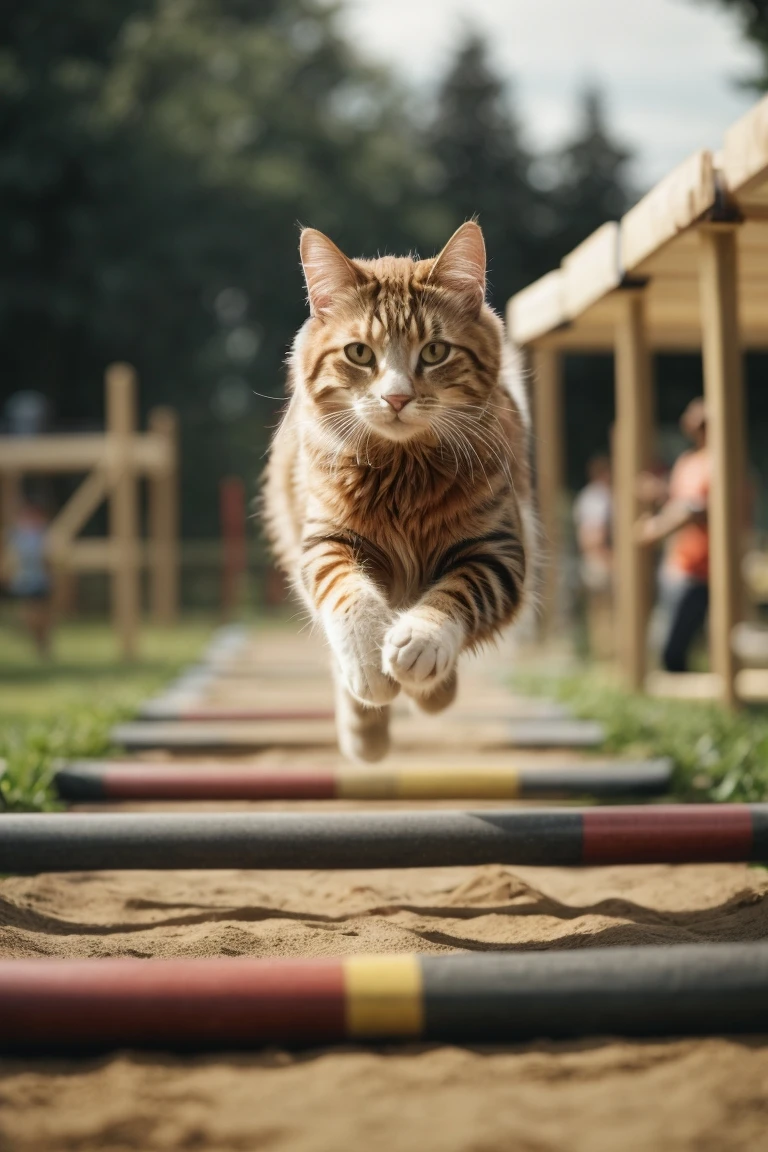Feline Agility: Training Your Cat for Physical Fitness

Feline agility is a fun way to engage your cat's natural athleticism and hunting instincts. Cats can learn to run through tunnels, leap over hurdles, climb platforms, and more. While dogs have dominated dog sports, agility is now becoming popular for cats as both a hobby and competition. With patience and motivation, you can train your cat for agility skills that will keep them mentally and physically fit.
Benefits of Feline Agility
Training your cat in agility offers many benefits:
- Provides physical activity to prevent obesity and related illnesses
- Stimulates their mind through learning new skills
- Strengthens the bond between you and your cat
- Channels hunting behaviors into positive outlets
- Builds confidence through mastering challenges
- Fun way to expend energy in indoor cats
Even older cats can enjoy basic agility training adapted to their physical abilities. Work at your cat's pace and keep sessions positive.
Choosing a Cat for Agility
While any cat can learn agility foundations, certain traits make training easier:
- Confident and outgoing - Shy cats may get overwhelmed by new obstacles and environments.
- Food motivated - Use treats to reward and motivate more reliably.
- Active and athletic - Naturally enjoy climbing and leaping.
- Intelligent and eager to learn - Pick up new skills more quickly.
- Young and healthy - Avoid arthritis or mobility issues. Kittens can start foundations like targeting.
Consider your individual cat's personality and adjust your training approach appropriately when introducing new agility skills. Go at their pace.
Basic Agility Equipment Needed
You don't need fancy equipment to teach feline agility foundations at home. DIY or purchase basic items like:
- Tunnels/chutes - Can use cardboard boxes with holes cut in the sides or soft fabric tunnels
- Low hurdles - Mini practice hurdles or upright brooms over dowels at first
- Platforms - Shaped carpet remnants or foam blocks make easy platforms
- Hoops - Use hula hoops or suspend larger hoops from stands
- Target stick - A target pad on a stick helps teach touch cues
- Cat treats - Irresistible tiny treats like PureBites are great motivators
- Clicker - Helps precisely mark desired behaviors
Invest in more specialized equipment as you progress if you enjoy the activity.
Step-By-Step Foundation Training
Follow these steps to build your cat's agility skills:
Get Your Cat Comfortable with Equipment
- Place tunnels, platforms, and other items around your home for free exploration. Pair with treats and praise so they form positive associations.
- Add props gradually once your cat is completely comfortable using earlier items. Watch for any fearful reactions.
Use Target Training
- Get your cat used to touching their nose to a target stick. Reward each touch with a treat and praise.
- Gradually move the target around encouraging them to follow and touch it. This teaches them to focus on and follow cues.
Shape Desired Behaviors
- Use shaping to train more complex skills like weaving poles or jumping hurdles. Reward any approximations toward the goal behavior.
- For example, reward looking at the hurdle at first. Then stepping towards it. Then touching it. Finally, hopping over it. Go at your cat's pace.
- Use a clicker or "yes!" marker word to precisely mark and reward the moments your cat offers the desired behavior.
Link Behaviors into Sequences
- As your cat reliably performs each individual skill, start chaining them together into sequences.
- Practice the whole sequence each session even if you have to lure them through at first. Over many reps, they will start performing the full sequence reliably.
- Keep sessions short and positive. Gradually increase difficulty by adjusting obstacle height or spacing as needed.
Generalize Skills to New Locations
Once your cat understands targets like touching a spoon on cue, practice asking for the skill in different locations and with different target objects. This teaches the skill itself rather than just performing in one context.
Cats thrive on mental stimulation. Keep adding new challenges to keep your agility cat engaged and fit!
Troubleshooting Common Training Challenges
Training cats presents some unique challenges:
Issue: My cat keeps jumping off or refusing obstacles.
Solution: Lower heights drastically. Go at their pace. Ensure they are comfortable with each individual obstacle before chaining together. End sessions before they get frustrated.
Issue: My cat wanders off and won't focus.
Solution: Train in a confined area without distractions at first. Use very high-value treats to keep their attention. Keep sessions short.
Issue: My cat seems afraid of the equipment.
Solution: Avoid forcing them. Let them approach voluntarily and reward any interest. Pair treats and play with the equipment so they association positive feelings with it.
Issue: My cat gets stressed/overwhelmed during sessions.
Solution: End on a good note before they get frustrated. Add challenges gradually over multiple short sessions. Give them breaks in their safe carrier if needed.
The key is knowing your individual cat and adjusting your training approach to suit their unique personality and abilities. Patience and creativity goes a long way in feline agility!
Additional Fun Skills to Train
Once your cat has agility foundations, you can add fun variety by training skills like:
- Retrieving specific toys
- Pushing a ball into a goal or hoop
- Ringing a bell target suspended above their heads
- Running through a moving hoop held by you
- Playing hide and seek with their favorite toys
- Turning in circles on cue for a fun trick
Cats can be clicker trained to perform all kinds of behaviors beyond agility skills alone. Tailor activities to your cat's natural interests and abilities for a rewarding activity you'll enjoy together!
Agility training provides terrific mental and physical enrichment for cats. While your cat may never become an elite competition athlete, teaching them basic agility fundamentals will keep them active, engaged and bonded with you for years to come.